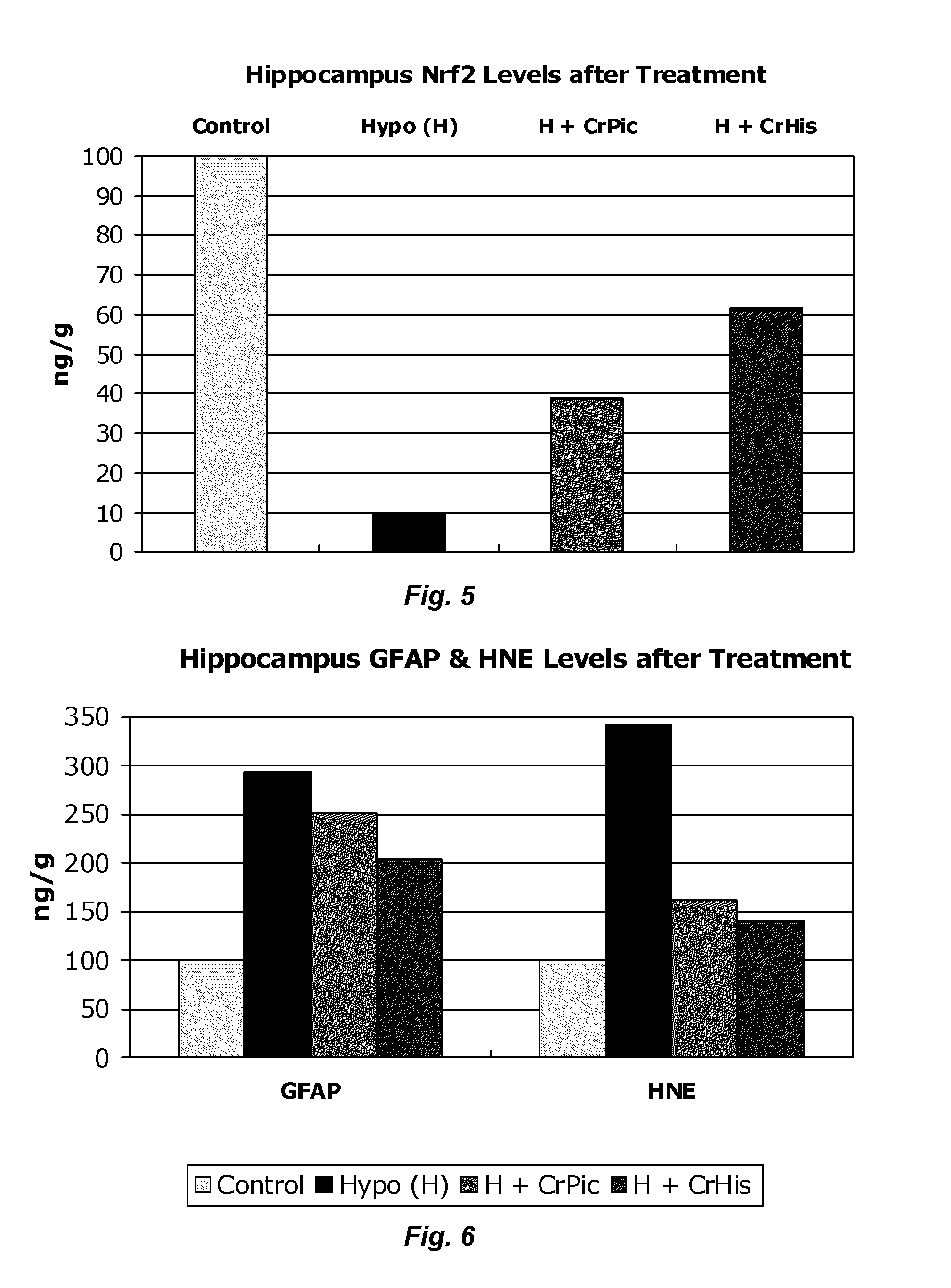Methods and compositions for the treatment and prevention of hypoglycemia and related disorders
- Summary
- Abstract
- Description
- Claims
- Application Information
AI Technical Summary
Benefits of technology
Problems solved by technology
Method used
Image
Examples
example 1
Chromium Reduces the Severity of Brain Damage in Insulin-Induced Hypoglycemic Rats
[0141]In order to evaluate chromium's potential protective effects preventing insulin-induced hypoglycemia, animals were administered insulin to induce hypoglycemia, and markers of hypoglycemic brain damage were compared in animals with and without administration of chromium.
[0142]Briefly, hypoglycemia was induced in Sprague-Dawley rats (males, 8-weeks old) by intraperitoneal injection of 15 U insulin / kg BW. The rats were separated into four groups of 15 rats each: (1) a control group not receiving insulin (“Control”); (2) a group not administered chromium (“Hypo”); (3) a group administered 110 μg / kg / day of chromium picolinate (CrPic); and, a group administered 110 μg / kg / day of chromium histidinate (CrHis). After one week of dosing, brains were removed from the sacrificed rats and analyzed for markers of hypoglycemic damage: GLUT-1; GLUT-3; Nrf2; GFAP; and HNE. The data are shown in Table 1 and FIGS. 1...
example 2
Chromium and Insulin can form a Chromium-Insulin Complex
[0150]In order to evaluate chromium's potential to form a complex with insulin molecules the following was performed.
[0151]100 μl of insulin (10 mg / ml) was mixed with 200 μl of chromium histidinate (“Cr-His”) (26 mg / ml) at room temperature (20° C.) which formed a white precipitate. The precipitate was collected by centrifugation and washed once with deionized water. The precipitate was then redissolved in 25 mM potassium phosphate buffer pH 7.4. The original supernatant and redissolved precipitate were then run through a size-exclusion column (for example, a 3 μM 100 Å column available from Agilent Bio having a resolving range of 100-100,000 Da; larger molecules eluting first) and analyzed with UV-Vis and ICPMS analysis.
[0152]Cr-His and insulin controls (i.e. same concentrations as in the Cr-His and insulin mixture) were run through the column. FIG. 14 shows the UV 280 nm plot of chromium histidinate alone while FIG. 15 shows t...
example 3
Chromium-Insulin Compositions Raise Serum Insulin Levels and Reduce Serum Glucose Levels in Normal Mice to a Greater Extent than Insulin or Zinc-Insulin Compositions
[0155]In order to evaluate the effect of chromium-insulin compositions on serum insulin levels and serum glucose levels in normal mice, the following was performed.
[0156]C57BL / 6 mice (five mice per study group) were injected with 0.5 U / kg of body weight i.p. of insulin in three different forms: insulin alone, zinc-insulin, and chromium-insulin.
[0157]Serum insulin levels were measured over time. The serum insulin levels were determined by rat insulin enzyme-linked immunosorbent assay (ELISA) kit from Crystal Chem (Downers Grove, Ill.).
[0158]FIG. 21 shows the results. As shown in FIG. 21, the same amount of insulin provided in the form of a chromium-insulin composition had a different, beneficial pharmacokinetic profile than the same amount of insulin provided as insulin alone and zinc insulin compositions. Of note, the ea...
PUM
| Property | Measurement | Unit |
|---|---|---|
| Mass | aaaaa | aaaaa |
| Mass | aaaaa | aaaaa |
| Mass | aaaaa | aaaaa |
Abstract
Description
Claims
Application Information
 Login to View More
Login to View More - R&D
- Intellectual Property
- Life Sciences
- Materials
- Tech Scout
- Unparalleled Data Quality
- Higher Quality Content
- 60% Fewer Hallucinations
Browse by: Latest US Patents, China's latest patents, Technical Efficacy Thesaurus, Application Domain, Technology Topic, Popular Technical Reports.
© 2025 PatSnap. All rights reserved.Legal|Privacy policy|Modern Slavery Act Transparency Statement|Sitemap|About US| Contact US: help@patsnap.com



